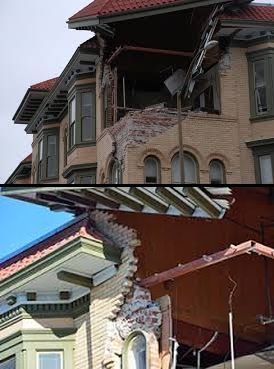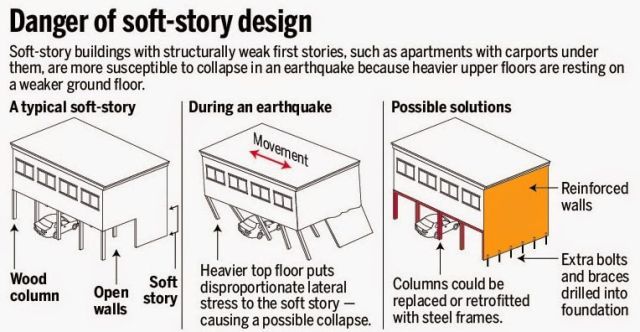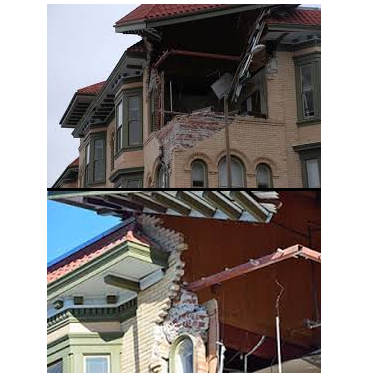About Earthquake Risk
California is earthquake country. The state has over 500 active faults, and most residents live within 30 miles of an active fault. There is a 99% chance of one or more magnitude 6.7 or greater earthquakes striking the state in the next 20 years. Earthquakes strike without warning, and early prediction technology isn’t reliable yet. You can learn about the earthquake risk in your county with this tool from the California Earthquake Authority.
More severe earthquakes are likely throughout California. In addition to the potential for “the big one”, the occurrence of smaller more frequent seismic activity can also cause significant damage and harm. When earthquakes happen, they are devastating for residents, infrastructure, economy, and critical lifelines.
Researchers believe that many parts of California are due for severe earthquakes in the next twenty years. Watch this video from the United States Geological Survey (USGS) to see what a M7.0 on the Hayward Fault would look like for East Bay, California.
Earthquakes are caused by the release of energy accumulated within or along the edges of the earth’s tectonic plates where seismic waves radiate around the origin epicenter and cause the ground to shake. Earthquakes are sometimes followed by tsunamis and land-deformation processes such as liquefaction, landslides, and subsidence.
- Tsunami: A series of ocean waves generated by sudden displacements and disturbances of the sea floor, such as earthquakes, underwater landslides, or volcanic eruption. Like earthquakes, tsunamis cannot be predicted, giving people little warning time to evacuate and prepare.
- Liquefaction: Earthquakes may cause water pressures to increase in the soil sediment and the sand grains to lose contact with each other, making the sediment flow like a liquid. Most liquefaction occurs in areas that have been artificially filled.
- Landslides: A landslide is a downward slope movement of rock or soil (or both), occurring on the surface of rupture. Landslides, triggered by earthquakes or heavy rainfall, often happen without warning and move very quickly.
- Land subsidence: The gradual settling and compaction or sudden sinking of the earth’s surface.
Impacts on Homes
Earthquakes increase ground instability and can cause buildings to collapse from structural and other property damage. Home foundations and structures crack under the movement of an earthquake. The greatest damage occurs when buildings are located on unconsolidated sedimentary rock, especially when it is saturated with water or when groundwater is high.
Subsidence can leave foundations less secure, increase risk of flooding in low-lying areas, and increases the rate of sea level rise because the ground is lower and may also allow for higher water tables and coastal surges. Landslides may topple homes built on unstable soil, burying anything they fall upon. They may also disrupt road access and prevent emergency crews from providing rescue, provisions, or repairs. Landslides are a risk after rains and earthquakes, when unstable conditions exist but are not visible. Earthquake-induced tsunamis can destroy buildings and infrastructure with high- energy wave action. They may bring with them debris that magnifies the damage to structures in its path and can spread debris over large areas. Tsunamis can also cause dramatic coastal erosion, impacting buildings at the water’s edge.
After any seismic event, land may not be safe to rebuild on. Homes must be inspected to ensure structural safety.
Housing types of concern in California

- Structures of unreinforced masonry are at great risk and vulnerable to smaller quakes than buildings built to current seismic codes (2018 International Building Code). Unreinforced masonry buildings are generally brick buildings constructed prior to modern earthquake-resistant design. The brick is not strengthened with embedded steel bars and is therefore called “unreinforced.” In earthquakes, the brick walls, especially parapets, tend to disconnect from the building and fall outward, creating a hazard for people below and sometimes causing the building to collapse.
- Soft-story buildings, often multi-story buildings in which one or more floors have windows, wide doors, large unobstructed commercial spaces, or other openings in places where a shear wall would normally be required for stability as a matter of earthquake engineering design. A typical soft-story building is an apartment building of three or more stories located over a ground level with large openings, such as a parking garage or series of retail businesses with large windows (pictured below). These types of buildings often contain affordable units, and frequently fail completely in a significant magnitude earthquake.

- Non-ductile buildings are structures that contain brittle concrete elements (columns, beams, walls, and connections) that tend to perform poorly during earthquakes due to the limited amount of reinforcing steel.
- Manufactured homes, often fabricated in a factory and built on what is called a “chassis”. These homes are often not built to withstand seismic stress and can fail during a quake. Utilities serving manufactured homes are also especially vulnerable to disruption.
Impacts on Frontline Communities
Frontline communities are often hit hardest when earthquakes strike. Due to high cost of housing and discriminatory housing policies, low-income communities and people of color tend to live in buildings that are more susceptible to severe earthquake damage, like those described above. Low-income communities and communities of color are also less likely to have earthquake insurance or have extra money or supplies to manage after a devastating earthquake.
According to the USGS HayWired Scenario, over 400,000 people — or 150,000 households — could be displaced from their homes and communities due to residential building damage and extended infrastructure outages. Alameda County, which would have the greatest numbers of people at risk of displacement in the scenario, also has some of the highest concentrations of vulnerable populations. With few vacant housing units available, it would be very difficult to provide an adequate supply of interim housing quickly, and many people could be forced to leave their communities or even the region, on a scale like San Francisco after the 1906 earthquake and New Orleans after Hurricane Katrina.
Actions to Take
For individuals
- Listos California has a list of low-cost actions you can take right now to prepare for an earthquake, available in many languages.
- Terremotos.org is also a great resource in Spanish about preparing, surviving, and recovering from an earthquake.
- Sign up for your county’s emergency alerts here.
- If you live in a house, learn about its seismic safety, and explore making upgrades to improve its earthquake resilience. Check with your local area’s Office of Building Safety to find out about available funding for retrofits. The California Earthquake Authority has some grant funding to support homeowners with their retrofits.
- If you live in an apartment, learn about the building’s structural seismic safety by requesting information from your property manager and landlord, and advocate for improvements. Your local Office of Building Safety or Office of Emergency Services can help you understand your landlord’s responsibilities and what you can do to ensure your building is safe. They may even have lists online of the most dangerous buildings in your community.
- If you live in a mobile home, explore options for making sure it is tied down and anchored.
- Standard Insurance policies doesn’t usually include damage from earthquakes. Explore earthquake insurance from the California Earthquake Authority.
For community-based organizations
- Explore options to inspect the seismic safety of your buildings and how you might improve them. Use this guide on Building Protection.
- Advocate for the retrofit of buildings and homes occupied by low-income tenants.
- Get involved in the hazard mitigation planning process and express the need for earthquake retrofitting. Make calls to your local representatives about this need.
- Organize mutual aid networks to support residents after the earthquake. Undocufund, which is a fund that serves people who are undocumented and aren’t eligible for federal assistance, is a great example.
- Coordinate with peer community-based organizations so that you can all support each other and build on each other’s strengths to support the community.
- Prepare yourself and your organization for an earthquake. You will not be able to support your community without taking care of your safety first! Train your staff and your community members about the importance of earthquake preparedness and what to do during an event. Your local Office of Emergency Services might also offer trainings on this very topic!
- Enterprise’s Business Continuity Toolkit for affordable housing organizations can help you prepare and respond. Another guide that will help housing owners and community organizations prepare for disaster response is Household Emergency Preparedness.
- Create systems of communicating with your community members during an earthquake assuming electricity may be unavailable. Systems could include identifying a community post board for note sharing, partnering up community households that have complimentary skills, and creating a meeting place outside of the community should there be a need to evacuate.
- Connect with your local Office of Emergency Services to receive information before, during, and after the earthquake. Other great places to get information include:
- Social media (look for official sources)
- Radio (usually an AM station)
- Wireless emergency alerts. Sign up for your county’s alerts here.
- Store emergency supplies including water, medical supplies, blankets, flashlights, batteries, and emergency radio.
- Have a backup power system. Use this resource from Enterprise on Energy Generation and Backup Power.
For local and State government
- Build relationships with frontline communities and offer support with preparing for an earthquake, including understanding risk, insurance, and different housing options.
- Create a Pre-Disaster Recovery Plan that describes how recovery will work after a severe earthquake and includes ways to prevent people from being displaced. For example, what is the plan to detail with waste and debris?
- California has a patchwork of seismic retrofit ordinances. Create local law that mandates the retrofit of all buildings that are susceptible to severe earthquake damage, like this one in Los Angeles.
- Develop more quality affordable housing so that California has safe places for low-income residents to live and remain in place should a disaster strike.
- Prioritize the retrofit of resilient and safe housing and infrastructure of neighborhoods that have been systematically disinvested through redlining and other policies.
- Grant more State funding to support the retrofit of unsafe buildings in local communities, with a prioritization on low-income families and neighborhoods.
- Work with the insurance industry to explore new models of insurance that can more provide low-cost insurance to low-income communities and offer mitigation support.
For philanthropy
- Fund community-based organizations to procure emergency supplies and support earthquake preparedness.
- Create a fund for owners with low income to afford earthquake insurance as well as renters to afford rental insurance that covers content loss and loss of housing.
- Create a plan to offer financial resources to mutual aid networks that pop up after an earthquake.
- Advocate for and fund the retrofit of low-income buildings and affordable housing at the State and local level.
Photo Source: City of Berkeley

- Toolkit